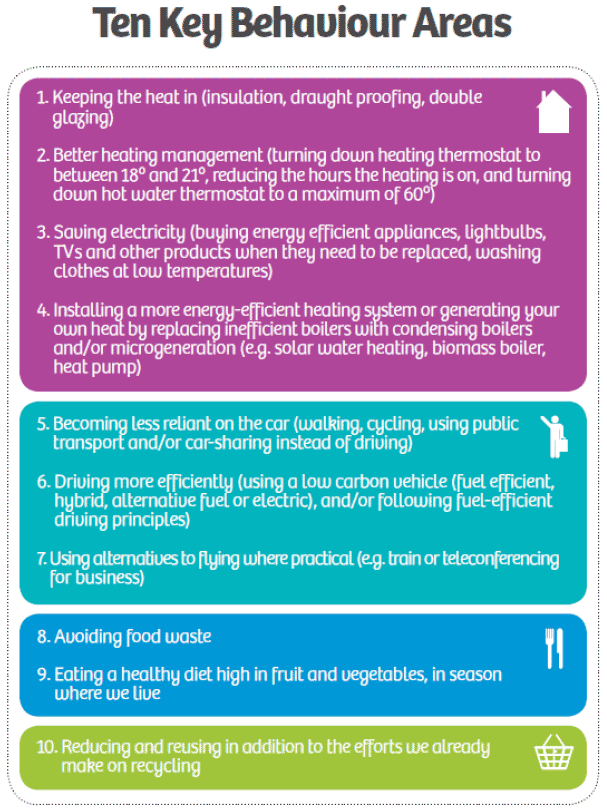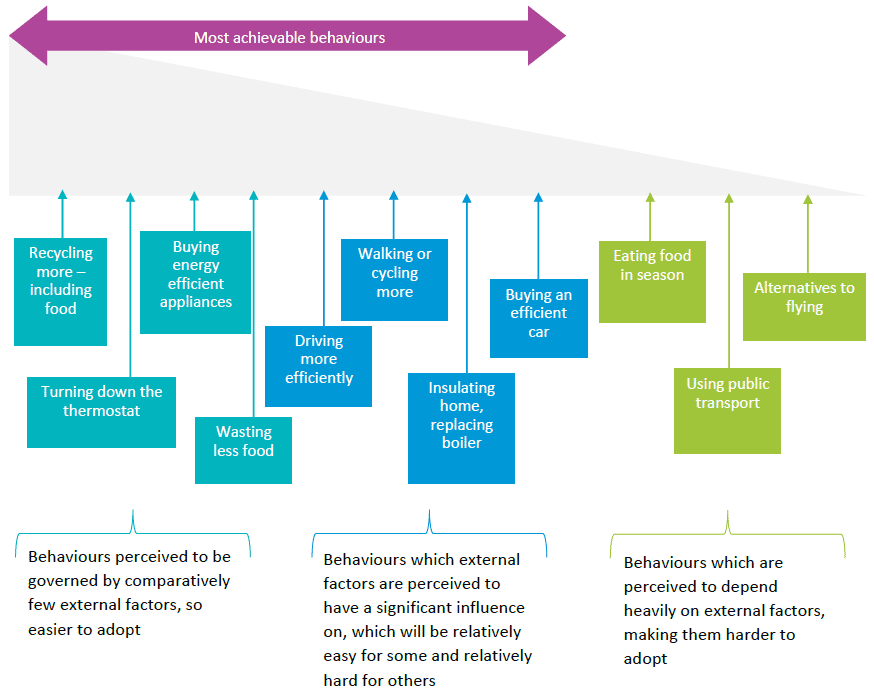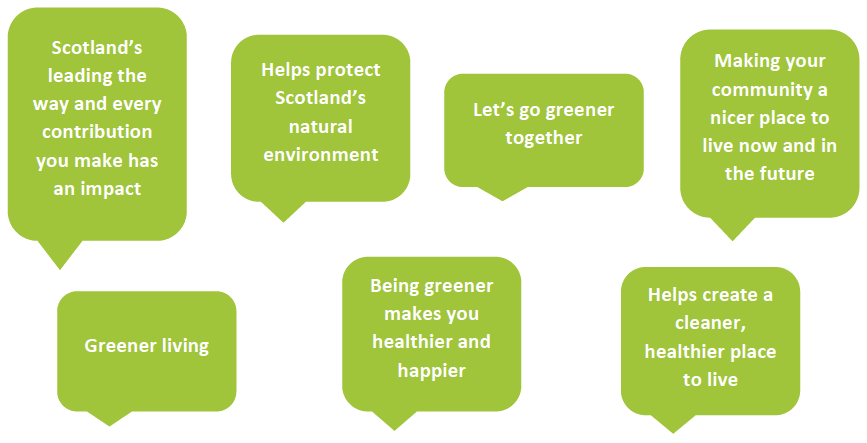Motivating low-carbon behaviours - insights from the Scottish Government
Insights from research commissioned to inform our social marketing campaigns concerning low carbon behaviours.
Section 1: What Drives Low Carbon Behaviours?
Our everyday actions and choices, such as the food we buy and the methods we use to travel, are governed by a whole range of internal and external influences such as habits, personality, time constraints, costs and social pressures. To understand how best to encourage the uptake of low carbon behaviours it's important to look at what factors influence these behaviours, as well as attitudes and feelings around the environment and climate. This section introduces the Ten Key Behaviour Areas, which have been the focus of Scottish Government's engagement on low carbon behaviour change, and goes on to explore the influences governing these behaviours and provide insights into how to motivate uptake of low carbon behaviours. This section draws on research conducted by Leith/2CV and TNS on behalf of the Scottish Government, which involved detailed surveys of the population as well as in-depth discussions carried out in people's homes.
The Ten Key Behaviour Areas
The Climate Change (Scotland) Act (2009) included a requirement to 'identify actions which persons in Scotland may take to contribute to the achievement' of Scotland's emission reduction targets [1] . Scottish Government carried out a Climate Change Behaviours Research Programme [2] to fulfil this requirement, identifying the behaviour areas with the greatest associated emissions, and investigating what relevant actions households could take to reduce their impact.

It was found that household consumption emissions fall into four main categories of housing, transport, food and consumption. Within these four main themes, Ten Key Behaviour Areas were chosen to be the focus of engagement with households and individuals on low carbon behaviours. They were chosen to be as easy to understand and adopt as possible, while providing significant emissions reduction potential. They are not intended as a 'to do list' for every member of the public to complete, but as a framework to guide and inform initiatives and engagement in the context of all the influences and barriers that affect behaviours. Trends in these Behaviour Areas are monitored as part of the regular tracking research presented in section 2, and inform social marketing campaigns and behaviour related interventions and policies.

Attitudes to 'Green' Behaviours
The research carried out for Scottish Government found that conversations around environmental or green behaviours can be hindered by the difficult nature of the issue, and off-putting associations with acting green.
- The environment is a complex issue - people care about it, but struggle to link caring to concrete action.
- It is common to believe in an all or nothing approach to environmental behaviours - Some people think the 'green lifestyle' must be bought into wholesale, which they might not consider to be practical or realistic.
- Some may consider being green to be outside of the mainstream, and being described as 'green' is not aspirational.
The recycling cul-de-sac
The main association with 'acting green' is recycling - it is the behaviour spontaneously mentioned by far the most when discussing combatting climate change.

The majority (over 2/3 of people surveyed) always recycle their household waste, but the research found that this does not necessarily lead onto other low carbon behaviours. The perceived strong association between combatting climate change and recycling can in fact inhibit the uptake of the other key behaviours, as people feel they are already 'doing their bit'.
Motivations for Low Carbon Behaviours
Although each of the Key Behaviour Areas has its own specific influences, common themes emerged in the research which highlight the need to appeal to more personal, practical aspirations when attempting to encourage uptake of climate friendly behaviours.
Carbon emissions and climate change:
For a range of reasons, carbon and climate change rarely motivate people to change their behaviour.
- They aren't major concerns for most people, and are very rarely spontaneously discussed.
- Carbon emissions are often associated with industry and energy companies, with many feeling there is little that can be done about carbon as individuals
- The link between personal actions and carbon is often unclear, with a risk of only associating personal carbon with vehicle emissions.
- Climate change is seen as a distant issue, and the responsibility of governments and energy companies.
- Personal actions are not seen as having an impact.
Recent external research [3] shows that that 21% of Scottish adults view climate change as the most important issue facing the world in 10 years time, second only to defence/foreign affairs/terrorism/war (32%). However only 3% consider it the most important issue facing Scotland in 10 years time. This reinforces the findings that climate change is not a pressing issue for most people compared with other more prominent current issues.
Personal motivators:
Other influences, more personal and closer to home, are likely to motivate people more than reducing carbon emissions or what is perceived as the distant threat of climate change. These include financial savings, aversion to waste and the benefits of improving the local environment.
- Saving money is commonly cited as a key reason for improving home energy efficiency, driving efficiently, and reducing and reusing.
- Improving quality of life and the local environment are particularly motivating.
- Older people are often naturally inclined to thriftiness and the 'make do and mend' mentality.
- Anything easy and straightforward to incorporate in daily life is welcomed.
- Yet many behaviours are considered to be a hassle, even if they are relatively easy to adopt.
Barriers to Low Carbon Behaviours
The most common reported barriers to behaviour change included cost, inconvenience, hassle and perceived effort. There was also some gaps in knowledge and understanding, such as the benefits of recycling food and the effectiveness of washing at low temperatures.

Targeting Low Carbon Behaviours
Asking people to take action in all of the Ten Key Behaviour Areas risks significant opt-out, as the task will appear too daunting to consider. A more effective approach suggested by the research is to highlight a few behaviours which are considered doable by most people as a starting point.
Behaviours with fewer external influences will likely be easier to adopt than behaviours that are effected by many external factors. The decision to turn down the thermostat, for example, is governed by fewer external factors than using public transport, which depends quite heavily, among other things, on the available infrastructure.
Organising key behaviours by their dependence on external factors gives a good guide to which are the most doable, and therefore which behaviours it makes sense to focus on for social marketing campaigns.

Communicating Effectively
Although each of the key behaviours has specific influences, the overarching narrative that frames these behaviours can still have a big impact on whether people are disengaged or motivated to act.
Research was conducted for Scottish Government into which phrases and calls to action put people off, and which inspire behaviour change [4] .
Unhelpful, off-putting language:

In general the research found that the more removed from a person's everyday experience a climate-related expression was, the more negative their response was.
Paradoxically, direct mention of climate can actually put people off acting to stop climate change, as it can be an intangible, distant issue, often thought of as only affecting future generations and people in other countries.
Similarly, language that was technical or associated with global or government level action was seen to be uninspiring, as it removes responsibility and control from the individual.
The term "carbon footprint", although widely used, was unhelpful in terms of inspiring a range of actions as it is mostly associated with travel emissions.
Helpful, inspiring language:

The most effective messages were those grounded in everyday experiences and aspirations, such as living a healthy lifestyle, that drew a clear link between an individual's actions and tangible benefits.
The research also found that drawing on ideas of collective action, shared goals and common gains made people feel their contribution was useful and worthwhile.
Contact
There is a problem
Thanks for your feedback